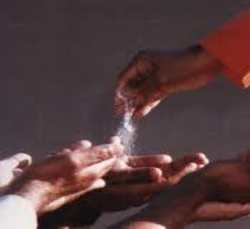In Addition
Obj 16 Sprawa 3
May / June 2025
1. Health article
Nurture the Mighty Muscles and enjoy Good Health
“It is the prime duty of every individual to take the greatest possible care of the body. The body is an indispensable vehicle for experiences. Without it nothing can be done, not even a simple task. The human body is, therefore, more precious than worldly wealth and such other material acquisitions. Life must be sanctified by making proper use of the body and engaging it in sacred actions.”… Sathya Sai Baba1
Introduction: In earlier issues (Vol 13 #4, Vol 15 #4, and Vol 16 #1 & 2), we learnt about preserving the health of our joints, brain, spine, and bones. Now, let us explore the vital role of our muscles and how to care for them.
1. Know your muscles
1.1 Nature of muscles: It is said “Muscles maketh man” and “Great ideas originate in the muscles”.2 Our muscles are composed of thousands of small fibres woven together like a quilt covering the body. More than 600 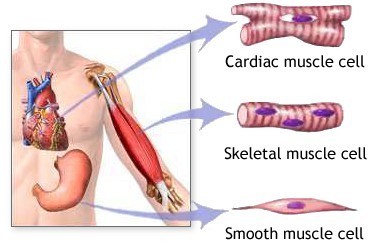 in number, muscles are distributed throughout the body, enabling movement, posture, and stability. They work in coordination with the brain and the nervous system, and are of three types: skeletal, cardiac, and smooth muscles.3-7
in number, muscles are distributed throughout the body, enabling movement, posture, and stability. They work in coordination with the brain and the nervous system, and are of three types: skeletal, cardiac, and smooth muscles.3-7
1.2 Skeletal muscles, also called striated muscles as they appear striped under a microscope, comprise 40% of human body weight and contain 50-75% of all body proteins. Primarily located between bones, they vary in structure in different areas such as the face, tongue, eye socket, diaphragm, and oesophagus. Facial muscles, for instance, are not directly attached to bone and enable rapid changes in expressions from a smile into a frown and vice versa even with smallest movement.3-7
Major skeletal muscles: Feel the amazing power of skeletal muscles by rotating your head around and moving it back and forth - the neck and upper back muscles support this movement. Some of the largest and strongest skeletal muscles are located in calves and thighs. Key muscles include 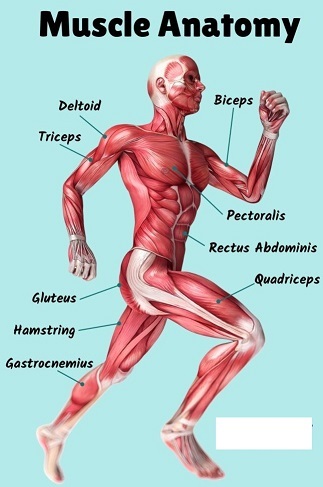 trapezius on neck and upper back, deltoid in shoulders, pectoralis on each side of upper chest, abdominis under rib cage, biceps and triceps on upper arm, quadriceps and hamstrings on front and back of thighs, gastrocnemius in calf, and gluteus at hip joints. Even within a single muscle, fibres are arranged to allow synchronized contraction, generating force and movement.5
trapezius on neck and upper back, deltoid in shoulders, pectoralis on each side of upper chest, abdominis under rib cage, biceps and triceps on upper arm, quadriceps and hamstrings on front and back of thighs, gastrocnemius in calf, and gluteus at hip joints. Even within a single muscle, fibres are arranged to allow synchronized contraction, generating force and movement.5
Functions of skeletal muscles: Working with bones, tendons, and ligaments, these muscles hold the skeleton together, stabilize joints, define body shape, maintain posture, generate  heat to maintain body temperature, store nutrients, support soft tissues, and regulate blood sugar levels. They often operate in pairs; when one muscle contracts, the opposing muscle relaxes, enabling joint movement. Although capable of quick, powerful contractions, skeletal muscles tire easily. Being voluntary muscles, most of their movement is consciously controlled eg, our hand will only stretch to pick something up when we want to.4-7
heat to maintain body temperature, store nutrients, support soft tissues, and regulate blood sugar levels. They often operate in pairs; when one muscle contracts, the opposing muscle relaxes, enabling joint movement. Although capable of quick, powerful contractions, skeletal muscles tire easily. Being voluntary muscles, most of their movement is consciously controlled eg, our hand will only stretch to pick something up when we want to.4-7
1.3 Cardiac muscle (myocardium) is found only in the heart's middle layer. It contracts and relaxes rhythmically to pump blood through the cardiovascular system. This is an involuntary muscle, the heart beats 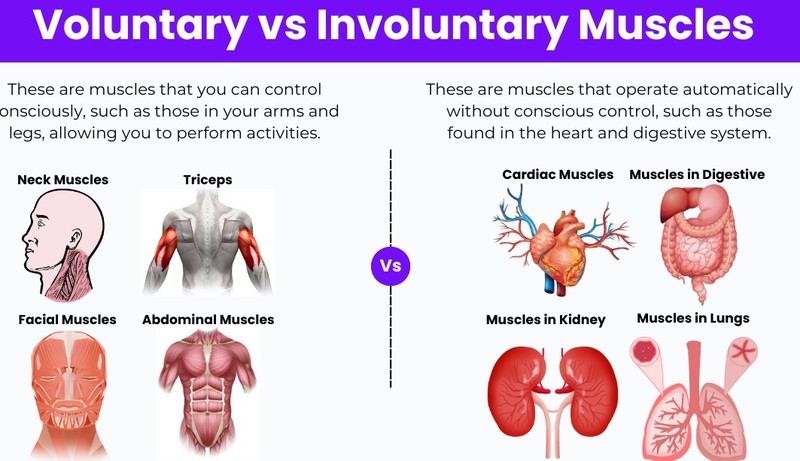 independently without conscious effort.3-5,7
independently without conscious effort.3-5,7
1.4 Smooth muscles primarily line the walls of hollow organs and blood vessels, one layer of muscle behind the other, in gastrointestinal, urinary, respiratory, and reproductive systems. They are essential for functions like aiding digestion, moving waste through intestines, helping the lungs expand during breathing, and regulating blood pressure. Unlike skeletal muscles, they contract slowly but can remain contracted for long periods without fatigue. Smooth muscles function involuntarily.3-5,7
2. Muscle disorders
2.1 Frozen shoulder (adhesive capsulitis), a musculoskeletal disorder, often develops after prolonged inactivity eg, post-surgery or fracture. People with diabetes, thyroid disorder, Parkinson’s disease or stroke are at higher risk. Symptoms include dull or aching pain and stiffness in shoulder joint, sometimes radiating to upper arm, which can gradually get worse limiting its mobility. Even simple activities like combing hair or 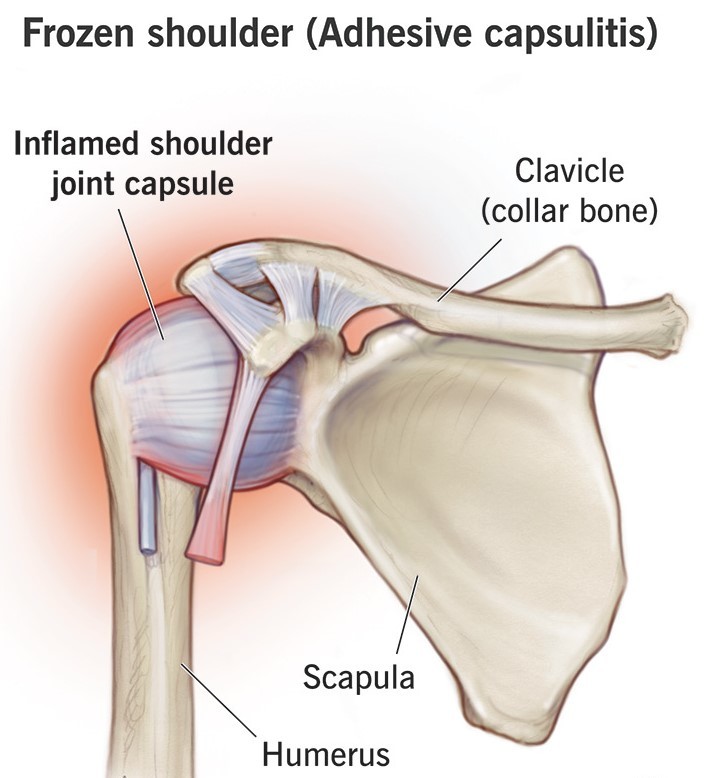 putting on a belt may become difficult. It progresses through three stages: Freezing, the most painful early stage, where pain worsens with movement and at night, lasting 6 weeks to 9 months; Frozen when the pain may lessen but stiffness persists for 2-6 months; and Thawing during which the pain starts to fade and mobility gradually returns over a period of 6 months to 2 years. Altogether, it takes 2-3 years for complete recovery and can occur in the other shoulder after 4-5 years. Early intervention with appropriate remedies and physiotherapy is crucial. Ice pack for 10-15 minutes several times a day in the freezing and thawing stages may reduce pain and swelling; during the frozen stage, a warm fomentation may help.8-13
putting on a belt may become difficult. It progresses through three stages: Freezing, the most painful early stage, where pain worsens with movement and at night, lasting 6 weeks to 9 months; Frozen when the pain may lessen but stiffness persists for 2-6 months; and Thawing during which the pain starts to fade and mobility gradually returns over a period of 6 months to 2 years. Altogether, it takes 2-3 years for complete recovery and can occur in the other shoulder after 4-5 years. Early intervention with appropriate remedies and physiotherapy is crucial. Ice pack for 10-15 minutes several times a day in the freezing and thawing stages may reduce pain and swelling; during the frozen stage, a warm fomentation may help.8-13
2.2 Fibromyalgia is a disorder characterized by widespread musculoskeletal pain on both sides of the body, above and below the waist (basically pain in all muscles and joints) coupled with constant fatigue, poor sleep, memory issues, and mood disturbances. Patients are hypersensitive to pain and often awaken tired, even after long sleep, experiencing cognitive difficulties (fibro fog) that impairs the ability to pay attention, concentrate or focus on mental tasks. It is neither autoimmune nor inflammatory and does not worsen over time, though symptoms may fluctuate. It often coexists with migraine or headache, TMJ disorders that affect jaw joints, irritable bowel syndrome, painful bladder, anxiety and depression. Though real cause is unknown, it is often triggered by a trauma, infection, hormonal changes, or psychological stress, women being at greater risk. The management of symptoms can be slow and challenging, it demands consistent self-care.14-16
2.3 Ataxia is loss of muscle control resulting in symptoms such as unsteady gait, clumsy walk with feet wide apart, loss of balance and muscle coordination in hand, arm, or leg, slurred speech, difficulty swallowing, and uncontrolled eye movements. Caused by damage to the cerebellum, it may result from stroke, tumours, multiple sclerosis, degenerative diseases, medications, vitamin B12 deficiency, or alcohol abuse; could be genetic too. It should not be confused with apraxia, a brain disorder that affects a person’s speech or movements though his muscles are not otherwise weak or paralyzed.17,18
2.4 Muscular dystrophy refers to a group of genetic conditions characterised by progressive muscle weakness and loss of muscle mass affecting 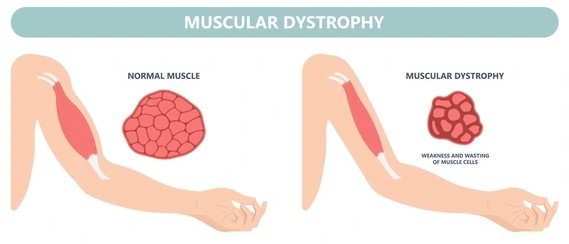 the ability to move, walk, and perform daily activities; it can affect the muscles of the heart and lungs too. Some signs which typically appear in childhood, more common in boys, are frequent falls, difficulty in rising from a lying or sitting position, trouble running or jumping, waddling gait, walking on toes, enlarged calves, muscle pain and stiffness, delayed growth, and learning disabilities.19,20
the ability to move, walk, and perform daily activities; it can affect the muscles of the heart and lungs too. Some signs which typically appear in childhood, more common in boys, are frequent falls, difficulty in rising from a lying or sitting position, trouble running or jumping, waddling gait, walking on toes, enlarged calves, muscle pain and stiffness, delayed growth, and learning disabilities.19,20
2.5 Myasthenia gravis is an autoimmune neuromuscular disorder where communication between nerves and muscles breaks down, weakening the skeletal muscles in the eyes, face, mouth, throat, neck, arms, and legs. Common symptoms are drooping eyelids, double vision, muscle 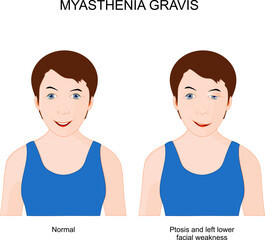 weakness and fatigue, difficulty in swallowing, breathing, pronouncing words, holding the head up, raising arms and walking, and facial changes eg, expression of smile into snarl! Symptoms usually improve with rest. Most patients can improve their muscle strength and lead normal or near-normal lives, but crises requiring urgent care can occur. People with arthritis or thyroid condition are at higher risk. Some medications, surgery, or an infection can act as triggers.21-23
weakness and fatigue, difficulty in swallowing, breathing, pronouncing words, holding the head up, raising arms and walking, and facial changes eg, expression of smile into snarl! Symptoms usually improve with rest. Most patients can improve their muscle strength and lead normal or near-normal lives, but crises requiring urgent care can occur. People with arthritis or thyroid condition are at higher risk. Some medications, surgery, or an infection can act as triggers.21-23
How to alleviate symptoms and prevent myasthenia flare-ups or crisis: Strengthen muscles through exercise under medical guidance; avoid exposure to heat; keep the body and mind energised and calm through proper diet, recreation, and healthy practices like meditation; tackle the most exhausting tasks earlier in the day, and take proper naps and frequent breaks throughout the day.22
2.6 Polymyositis is a rare autoimmune inflammatory disease that attacks muscles close to the centre of the body. Common symptoms are muscle weakness especially in shoulders and hips, persistent fatigue, joint pains and stiffness right after waking, fever, and weight loss.24
3. Muscle injuries and overuse
3.1 Sprain and Strain: Common in sportspersons, a “sprain” happens due to overstretching or tearing of a ligament, the most common location being the joint in ankle, knee, wrist, or thumb. A “strain” is due to 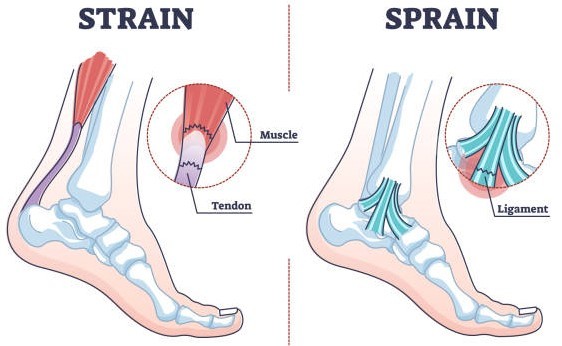
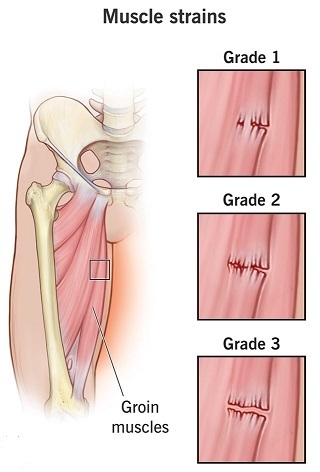 overstretching or tearing of a muscle or tendon, mostly in hamstring and lower back; often these terms are used interchangeably. Risk factors are: putting a lot of pressure on one joint or muscle, doing a sport without preparation, proper equipment, or warming up or after a long time gap. The symptoms for both sprain and strain are pain, swelling, reduced flexibility, and limited joint movement; sprains often cause bruising but strains may cause muscle spasms. Other common symptoms of a muscle injury are weakness, cramps, and skin discoloration. A cramp or a spasm could also be due to dehydration or after over-activity.25-27
overstretching or tearing of a muscle or tendon, mostly in hamstring and lower back; often these terms are used interchangeably. Risk factors are: putting a lot of pressure on one joint or muscle, doing a sport without preparation, proper equipment, or warming up or after a long time gap. The symptoms for both sprain and strain are pain, swelling, reduced flexibility, and limited joint movement; sprains often cause bruising but strains may cause muscle spasms. Other common symptoms of a muscle injury are weakness, cramps, and skin discoloration. A cramp or a spasm could also be due to dehydration or after over-activity.25-27
3.2 Plantar fasciitis, inflammation of the plantar fascia - ligament running from heel to toes, is commonly caused by overuse of or too much stress on the feet; this results in heel 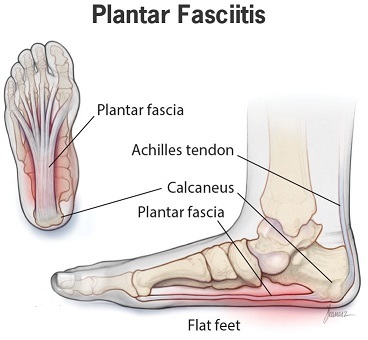 pain. 28-30
pain. 28-30
3.3 Myofascial pain syndrome, often confused with fibromyalgia, arises from inflammation of muscles, mostly in one specific area but sometimes, in 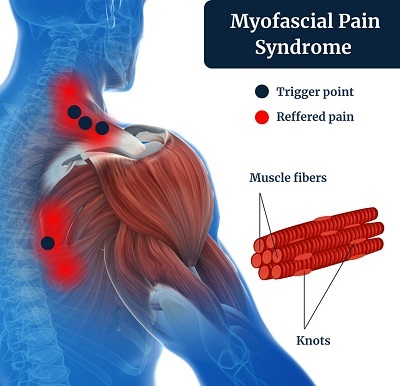 multiple areas on the same side of the body. Common causes are injury, repetitive motions like hammering, tensing the muscle over and over, and poor posture. It is not easily diagnosed due to overlapping of its symptoms with other conditions affecting the nerves, bones, ligaments, and tendons.31
multiple areas on the same side of the body. Common causes are injury, repetitive motions like hammering, tensing the muscle over and over, and poor posture. It is not easily diagnosed due to overlapping of its symptoms with other conditions affecting the nerves, bones, ligaments, and tendons.31
4. Tackling a muscle injury
- Refer to spine and bone health articles (Vol 16 #1 & #2) for detailed exercises and first aid.30,32
- Follow the "PRICE" or "RICE" method 26,27,36:
- Protect the injured body part by using a support, eg, shoes to support the foot or ankle.
- Rest: Avoid the activity that caused the injury and avoid using the injured part or putting any weight on it.
- Ice: Wrap ice packs or a bag of frozen peas in a towel or a thin cloth and apply this cold compress for 15-20 minutes at a time, every 2-3 hours.
- Compression: Wrap an elastic bandage around the injured part to help reduce swelling.
- Elevation: Keep the injured part raised above the level of heart, as much as possible and as often as possible.
- Avoid hot packs or baths during the acute phase (first 2–3 days). 26,36
- Seek medical treatment promptly for guidance.
- Recovery usually takes about two weeks but avoid strenuous activity like running during this period. 26,36
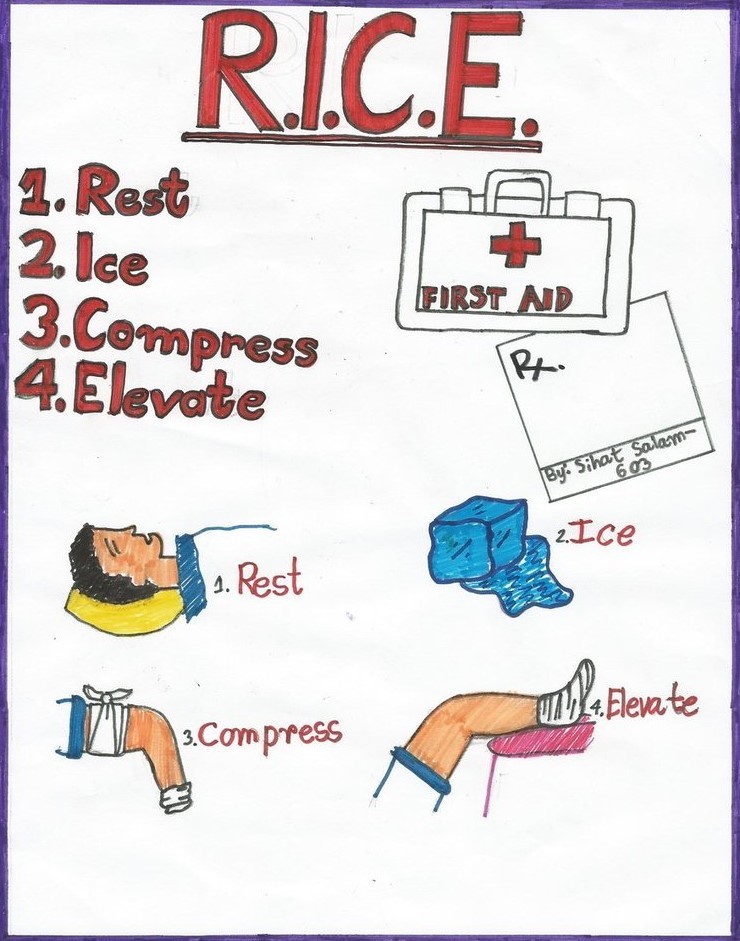
5. Tips to prevent muscle injury26,27,30,32-36
- Develop a balanced fitness routine with cardiovascular, strength, and flexibility exercises.
- Always warm up and stretch before activities; never begin abruptly or jerkily.
- Use appropriate equipment, sportswear and well-fitting footwear.
- Gradually increase time of activity and exercise intensity so as not to get tired; stay hydrated and maintain a healthy diet.
- Cool down and stretch after exercising, cool-down to be twice as long as warm-up.
- Rest adequately between intense activities, allowing enough time for body to recover; avoid pushing through pain.
- Listen to your body's signals.
6. Final word: Self-care and healthy habits are the best health insurance!
References and Links
- Sathya Sai Speaks, 17 May 2000, Summer course, Brindavan: https://saispeaks.sathyasai.org/discourse/human-body-and-its-importance
- https://www.catalign.in/2009/11/thomas-edison-father-of-systematic.html
- Muscles: https://my.clevelandclinic.org/health/body/21887-muscle
- https://kidshealth.org/en/parents/bones-muscles-joints.html
- Skeletal muscle physiology: https://www.ncbi.nlm.nih.gov/books/NBK537139/#
- Major skeletal muscles: https://kidshealth.org/en/kids/muscles.html
- https://www.healthdirect.gov.au/bones-muscles-and-joints
- Frozen shoulder: https://www.mayoclinic.org/diseases-conditions/frozen-shoulder/symptoms-causes/syc-20372684
- https://orthoinfo.aaos.org/en/diseases--conditions/frozen-shoulder
- https://ultracarepro.in/blogs/shoulder-pain/frozen-shoulder-symptoms-causes-and-treatment
- https://my.clevelandclinic.org/health/diseases/frozen-shoulder-adhesive-capsulitis
- Releasing a frozen shoulder: https://www.health.harvard.edu/pain/how-to-release-a-frozen-shoulder
- https://aidmyfrozenshoulder.com/frozen-shoulder/ice-vs-heat-for-frozen-shoulder.php#
- Fibromyalgia: https://www.mayoclinic.org/diseases-conditions/fibromyalgia/symptoms-causes/syc-20354780
- https://my.clevelandclinic.org/health/diseases/4832-fibromyalgia
- https://rheumatology.org/patients/fibromyalgia
- Ataxia: https://www.mayoclinic.org/diseases-conditions/ataxia/symptoms-causes/syc-20355652#
- https://my.clevelandclinic.org/health/symptoms/17748-ataxia
- Muscular dystrophy: https://my.clevelandclinic.org/health/diseases/14128-muscular-dystrophy
- https://www.mayoclinic.org/diseases-conditions/muscular-dystrophy/symptoms-causes/syc-20375388
- Myasthenia gravis: https://www.hopkinsmedicine.org/health/conditions-and-diseases/myasthenia-gravis
- https://my.clevelandclinic.org/health/diseases/17252-myasthenia-gravis-mg
- https://www.mayoclinic.org/diseases-conditions/myasthenia-gravis/symptoms-causes/syc-20352036
- Polymyositis: https://my.clevelandclinic.org/health/diseases/12053-polymyositis
- Muscle injuries: Sprain v strain: https://www.healthline.com/health/sprain-vs-strain
- https://www.nhs.uk/conditions/sprains-and-strains/
- https://www.topdoctors.co.uk/medical-dictionary/muscle-injuries
- Plantar fasciitis: https://my.clevelandclinic.org/health/diseases/14709-plantar-fasciitis
- Health article on joints:vol 13 #4, July-Aug 2022: https://news.vibrionics.org/en/articles/377
- Injury & prevention: Health article on spine: vol 16 #1 Jan/Feb 2025: https://newsletters.vibrionics.org/english/News%202025-01%20Jan-Feb%20RG.pdf
- Myofascial pain syndrome: https://my.clevelandclinic.org/health/diseases/12054-myofascial-pain-syndrome
- Prevent & tackle injuries: Health article on bones: vol 16 #2, Mar/Apr 2025: https://newsletters.vibrionics.org/english/News%202025-03%20Mar-Apr%20RG.pdf
- Prevent injuries: https://my.clevelandclinic.org/health/diseases/17873-dislocation
- https://www.hopkinsmedicine.org/health/conditions-and-diseases/sports-injuries/preventing-sports-injuries
- https://my.clevelandclinic.org/health/diseases/22336-muscle-strains
- https://my.clevelandclinic.org/health/treatments/rice-method
2. Camps & Clinics
1. Ananda Sai Mandir, Sujatha Nagar, Visakhapatnam, AP, 6 Mar 2025:
At the request of local Bhajan Group, this camp was inaugurated on 6 Mar 2025 after their evening bhajan. Senior Practitioner 11567 gave a brief introduction about Sai Vibrionics to about sixty devotees and answered questions from the audience. Practitioner 11648 introduced the Immunity Booster and talked about the precautions to be followed while taking remedies. This camp will be run initially once a month on every 2nd Sunday.
The first camp was successfully held on 9 Mar by Practitioner 11648 and her spouse from 4:30 pm to 10:00 pm; altogether fifty one patients were given remedies for various ailments. They were truly impressed by the hospitality extended to them by the Samiti members.

2. Gayatri Chetana Kendra, Sriram Nagar, Srinagar, Gajuwaka, Visakhapatnam, AP, 6 Apr 2025
This Camp was inaugurated on 6 Apr 2025 at their Gayatri Chetana Kendra, the local arm of All World Gayatri Pariwar. The latter is a global entity in Haridwar, with initiatives in holistic health and other welfare projects to bring about a transformative shift in society. This took place on the auspicious occasion of Sri Rama Navami after the completion of Gayatri Homam. Senior Practitioner 11567 gave a brief introduction about Sai Vibrionics to a large audience that included the trustees of the Kendra; 125 bottles of Immunity Booster were distributed to all those present.
This camp will be run initially once a month on 2nd Sunday by Practitioners 11634 & 18009 who successfully held the first camp on 13 Apr 2025 from 10:00 am to 12:30 pm; and treated eleven patients for various ailments.

3. Gattumalla Village, Bhadradri Dist, Telangana State, 24 Apr 2025
On the sacred occasion of Aradhana Mahotsavam, a special camp was held by the Regional coordinator 11585 at Gattumalla, a remote tribal village, 12 kilometers away from its nearest town Palvoncha. During the camp, 38 patients received personalized vibrionics remedies, lovingly offered as Swami’s prasadam. A range of health conditions were addressed, including cold and cough, fever, ear and eye problems, skin issues, gastric discomfort, joint and muscle pains, anaemia, headaches, wounds, allergies, and various female health concerns. The session served as a humble act of love and healing, bringing much-needed care to a remote community while honouring the legacy of selfless service exemplified by Bhagawan Baba.
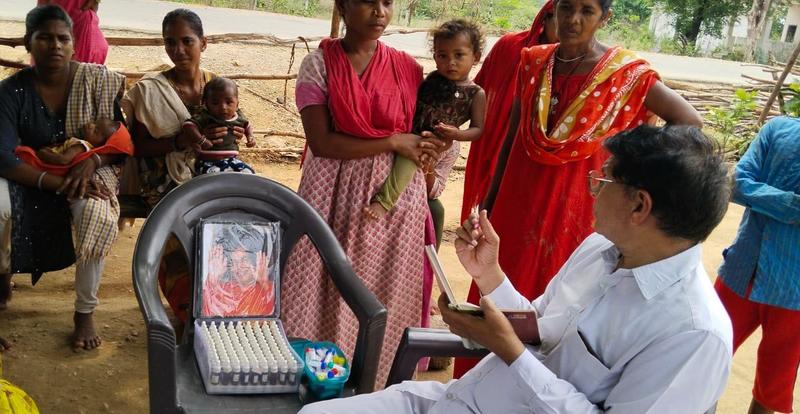
3. Practitioners Meet
3.1 Pune, Maharastra - 26 March 2025
Twelve enthusiastic practitioners attended a full-day meeting held at Sai Nilayam, Pune. The discussions focused on submitting successful case histories and extraordinary experiences, as well as identifying new locations to hold vibrionics camps. Many case histories and extraordinary experiences were collected by volunteer-practitioners during the meeting; these will be refined and prepared for publication in a book being offered to Swami for His centenary celebrations. A few more practitioners submitted their case histories following the meeting.
In one hour-long enlightening address, Dr Aggarwal emphasized that the true essence of patient seva lies in serving ourselves, leading to our own self-transformation. He stressed the importance of expanding our reach by organizing camps in places such as temples, gurudwaras, old-age homes, orphanages, animal shelters, and Sai centres (venues not explored earlier), after obtaining consent from the concerned officials. A senior practitioner can conduct introductory talks, using power point presentations and the video "What is Vibrionics?". For help with presentation material, write to [email protected]. This should be followed by launching regular camps at these locations.
He also encouraged practitioners living in the same area to meet informally, perhaps once a month, to discuss cases, patients, and the Vibrionics system, rather than wait for city-level meetings to be convened by the Regional Coordinator. Such regular interactions, he said, would help practitioners bond more closely and stay motivated. Another innovative suggestion from Dr Aggarwal was for each practitioner to organize quarterly meetings with their patients residing nearby, inspiring them to share their vibrionics experiences and health tips with others.
The meeting included a recharging session and concluded with a heartfelt aarti to Swami. All practitioners left with renewed enthusiasm, affirming their commitment to vibrionics.

3.2 Chennai, Tamil Nadu - 6 Apr 2025
Tamil Nadu Sai Vibrionics team held a meeting and recharging session on 6 April 2025 at the residence of Practitioners 11586&11616. It began with heartfelt prayers, creating a serene and focused atmosphere for the recharging session that followed.
The practitioners shared their enriching experiences, highlighting the diverse and compassionate applications of Sai Vibrionics. Practitioner 11653 shared his inspiring work using vibrionics remedies for pregnant cows and for enhancing the health of crops on his organic farm by putting Plant tonic in the well, used for irrigation. Practitioners11220, 11616, 11639 presented several case studies, prompting insightful discussion on remedy selection and outcomes. Practitioner 02792 captivated the group with his testimony of treating over 1,000 patients and shared how he was divinely guided by Swami to learn and serve through vibrionics. Practitioner 11599 shared a few remarkable cases where improvement was more pronounced while using single remedies from cards. He emphasized the need for practitioners to deepen their understanding of medical terminology and pharmacology, as this will enhance the accuracy and effectiveness of remedy selection.
The meeting concluded with a renewed sense of purpose and dedication to Swami’s mission.
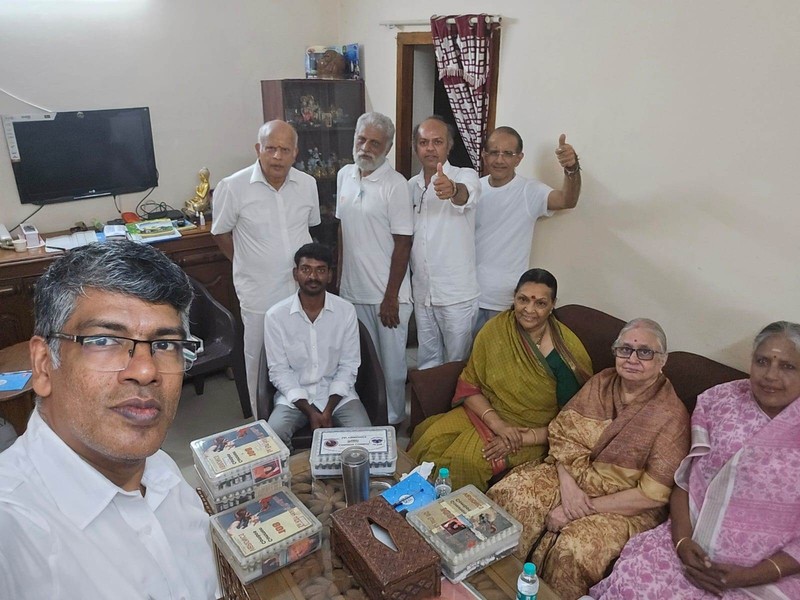
4. Anecdote
From the diary of Dr Jit K Aggarwal -- The ‘Darshan Pill’: A Touch of Healing During the Golden Days
It was the late 1990s, those formative years of Sai Vibrionics, when each experience felt divinely orchestrated. Having seen the almost immediate relief NM20 Injury provided for acute aches and pains, I developed deep trust in its power and soon began carrying a small bottle with me wherever I went.
It was a golden era: our beloved Swami was giving long, blissful darshans, and devotees sat for hours in eager anticipation, often packed closely together. One day at Prashanti Nilayam, I noticed an overseas devotee beside me, visibly uncomfortable. When I gently enquired, he shared that he wasn’t used to sitting on the floor for long and was in considerable pain, which was distracting him from the divine experience. Without hesitation, I offered him a pill from my NM20 bottle*, always close at hand. Within minutes, he relaxed and looked relieved. Curious, he asked, “What was that?” Smiling, I half-joked, “It’s a darshan pill.”
We laughed quietly, but word soon spread. Other devotees began approaching me for the now playfully nicknamed “darshan pill.” Behind the humour was something more meaningful how Swami’s grace, through vibrionics, could ease discomfort and bring peace, allowing devotees to fully absorb His presence.
Looking back, it wasn’t just about pain relief. It was about being quietly ready to serve, even in a crowd, offering love and comfort in the smallest, most heartfelt way, just as Swami would have wanted.
* If using the 108CC box give: CC10.1 Emergencies + CC20.7 Fractures
